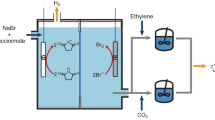Abstract
IN a recent communication1 Gulbransen showed that reactions between graphite and hydrogen which are thermo-chemically unfavourable can proceed to a measurable extent under conditions where the reaction products are rapidly removed or the system quenched. In view of this it is considered of interest to report certain observations made in these laboratories during experiments in which graphite was mechanically ground in the presence of hydrogen, and also of nitrogen. It was found that both these gases are taken up by graphite if present in the grinding chamber during the comminution process. The grinding was carried out using a vibratory ball mill fitted with gas-tight grinding chambers to which the gas was metered during grinding to maintain the pressure constant at 1 atm. The graphite was synthetic and contained less than 0.02 per cent of ash by weight, while the gases were of commercial quality at 99.9 per cent purity. The grinding medium was 0.25 in. steel balls. We concluded that the absorption of the gases must be due to some form of chemical reaction with the graphite for the following reasons. First, direct adsorption of the gases by the fresh graphite surface produced cannot wholly account for the uptake, because the extent of uptake is greater than when the graphite is first ground in vacuo and then placed in contact with the gas, even though the amount of fresh surface produced is greater in the latter case. Second, it is reasoned that neither hydrogen nor nitrogen reacts with the active (free radical) sites produced by fracture of the graphite planes, because we have shown that these are most readily neutralized by subsequent treatment with oxygen and that the amount of oxygen absorbed depends only on the fresh surface produced, irrespective of whether the graphite is initially ground in hydrogen, nitrogen or in vacuo. Finally, we have observed that graphite ground in the presence of nitrogen has a strong smell resembling that of hydrogen cyanide, whereas no such smell is detectable if the grinding is carried out in vacuo.
This is a preview of subscription content, access via your institution
Access options
Subscribe to this journal
Receive 51 print issues and online access
$199.00 per year
only $3.90 per issue
Buy this article
- Purchase on Springer Link
- Instant access to full article PDF
Prices may be subject to local taxes which are calculated during checkout
Similar content being viewed by others
References
Gulbransen, E. A., Nature, 212, 1420 (1966).
Bowden, F. P., and Tabor, D., The Friction and Lubrication of Solids (Oxford University Press, 1950).
Author information
Authors and Affiliations
Rights and permissions
About this article
Cite this article
PALMER, D. Reaction of Hydrogen with Graphite. Nature 215, 388–389 (1967). https://doi.org/10.1038/215388a0
Received:
Revised:
Issue Date:
DOI: https://doi.org/10.1038/215388a0
Comments
By submitting a comment you agree to abide by our Terms and Community Guidelines. If you find something abusive or that does not comply with our terms or guidelines please flag it as inappropriate.



